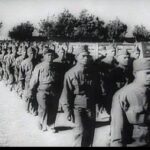
This still photo was taken from a stock footage film made by the U.S. Army Signal Corps during World War II. A military newsreel which featured Filipino soldiers training In California showed the “FIRST ALL-FILIPINO REGIMENT” of the U.S. Army.
The 1st Filipino Battalion was originally formed at Camp San Luis Obispo, California on April 1st, 1942. The cadre was comprised of survivors who were Noncommissioned Officers (NCO’s) from the Philippine Scouts and the Philippine Commonwealth Army. They had escaped after the Fall of Bataan and were fortunate to arrive to the states via the SS Mactan which was disguised as a hospital ship.
While recuperating, they were ordered to report to the Battalion at Camp San Luis Obispo. With recruits arriving from all parts of the country, the unit was forced to relocate to the California Rodeo Grounds in Salinas. It was here that the 1st Filipino Infantry Regiment was activated on July 13th, 1942. At the same time, more inductees continued to roll in each day. It returned back to Camp San Luis Obispo until October.
In the middle of that month, the Regiment relocated to Fort Ord to occupy a temporary “tent city” in the East Garrison. This was due to the shortage of barracks on the main garrison. Once billeting became available, the Filipino troops moved onto the main post and by October 14th, 1942, the 2nd Filipino Regiment was created.
While the 2nd Regiment moved to Camp Cooke in early 1943, the 1st Regiment made a transfer to Camp Beale (near Marysville) during the winter of 1943. In a historic event on February 20th, 1943,over 1,200 Filipino soldiers were naturalized in a mass ceremony.
The 1st Regiment then transferred to the Hunter Liggett Military Reservation and Camp Roberts in the summer of 1943 for intensive training. Another four (4) minute segment was filmed to show the progress and update on their training. Entitled, “ON TO BATAAN.” It became a reminder of the atrocities which occurred on the Bataan Peninsula in April 1942. By late 1944, “California’s Own” “Fighting Filipinos” would finally be able to deploy to the Southwest Pacific.
“LAGING UNA” – “ALWAYS FIRST”
“SULUNG” – “FORWARD”
“BAHALA NA!” – “COME WHAT MAY!”
“IN HONOR OF OUR FATHERS NEVER FORGETTING OUR MOTHERS!!!” — at the California Rodeo Grounds in Salinas, CA.










Leave a Reply